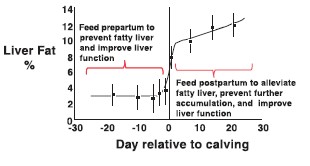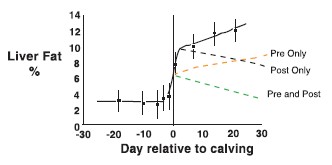ReaShure – Precision Release Choline Feeding Recommendations
概述
Choline is an essential nutrient that functions in gene expression, nerve transmission, cell membranes, and lipid transport. The classic choline deficiency symptom is fatty liver. Choline deficiency during the transition period prevents adequate processing and export of fatty acids from the liver and to the mammary gland as very low density lipoproteins; hence fatty acids are diverted towards deposition as fat or conversion to ketone bodies such as beta-hydroxybutyrate, acetone, and acetoacetate.
Feeding ReaShure® Precision Release Choline during the transition period has been shown to be effective in improving liver function, reducing fatty liver, ketosis and energy related disorders (Strang et al., 1998; Lima et al., 2012). In contrast to nonruminants, dairy cows cannot be fed free dietary choline. Choline must be fed in a form that prevents extensive degradation by rumen micro-organisms. Feeding rumen-protected choline to transition dairy cows not only improves health; a summary of 13 transition cows studies indicates it also increases milk production by approximately 5 lb/day (Grummer, 2012).
Recommended Feeding Rate
From early data obtained by Cornell University (Piepenbrink et al., 2003), it was concluded that 60 g/day of ReaShure was the best dose to benefit liver health and milk production. Since that study, the vast majority of transition cow trials have fed approximately 60 g /day both pre- and postpartum. Because there is a large data base with feeding the 60 g/day dose, there is confidence in recommending it and it is strongly recommended not to deviate from it. Jersey cattle are lighter, and it is often asked if a lower dose would be adequate. Perhaps, but a dose response study has not been conducted with Jersey cows. Therefore, 60 g/day is suggested for Jerseys and all other dairy breeds.
Recommended Feeding Period
Dairy cows can synthesize choline endogenously; however, the transition period represents a window of time in which endogenous choline production is insufficient. This is due to the dramatic increase in NEFA uptake by the liver that begins at calving and continues post calving (Figure 1, Reynolds et al., 2003). Figure 2 shows the progression of fat deposition in the liver of transition dairy cows and provides key insight into when choline is deficient. The greatest rate of fat deposition occurs during a surge in fatty acid mobilization on the day of calving. Choline deficiency may continue after calving as NEFA uptake by the liver remains elevated due to negative energy balance.
21 days Prepartum – feeding ReaShure for 21 days prepartum is recommended so that choline is circulating to the liver at the time of calving to help package and transport fat to the mammary gland while reducing deposition in the liver during the time when fat infiltration is greatest (Figure 2; Vazquez-Anon et al., 1994). If we knew the exact day of calving, feeding ReaShure 3-4 days prior to calving would probably be sufficient. Since we do not know the exact day of parturition, it is recommended to initiate feeding at 21 days prepartum to accommodate traditional prepartum grouping strategies.
21 days Postpartum – it is recommended that feeding ReaShure be continued for 21 days postpartum. Feeding postpartum will assist the liver exporting needed triglycerides to target tissues like the mammary gland, deplete fat that accumulated during parturition and help prevent further fat accumulation in the liver during negative energy balance (Figure 2). Feeding ReaShure postpartum should continue until the period of greatest negative energy balance has subsided and NEFA uptake by the liver is moderated to the extent that the endogenous supply of choline can adequately facilitate normal liver function. The length of this period will vary among herds and among cows within a herd. By 21 days postpartum, cows in most well managed herds will no longer experience dramatic elevations in NEFA uptake by the liver (e.g., see Figure 1); therefore, the need for feeding ReaShure is diminished.
Not all farms will have transition cow grouping strategies that precisely align with the ReaShure “recommended” feeding window of 21 days prepartum through 21 days postpartum. That should not preclude feeding ReaShure. For example, ReaShure should still be fed to prefresh groups that begin any time before 10 days prior to calving. Likewise, ReaShure should be fed to any postfresh group with the understanding that benefits may begin to be diminished after cows are beyond 21 days postpartum.
Also, some farms may not have a pre- and postpartum group. This should not preclude feeding ReaShure only during the prepartum period or only during the postpartum period! Figure 3 shows expected results of feeding ReaShure prepartum only, postpartum only, and both pre- and postpartum on liver fat accumulation which is indicative of a choline deficiency and impaired liver function. Clearly, feeding pre- and postpartum would be most beneficial, but feeding either pre- or postpartum should provide benefits to the cow by improving liver function.
Topdressing ReaShure can be an option for some dairy farmers. ReaShure is palatable and readily consumed by the vast majority of cows when topdressed. Using computerized feeders to tailor feed ReaShure to designated cows is also a successful feeding strategy.



